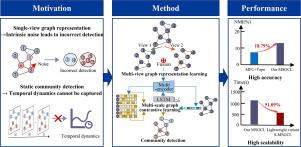Multi-scale graph contrastive learning for community detection in dynamic graphs
IF 6.9
1区 管理学
Q1 COMPUTER SCIENCE, INFORMATION SYSTEMS
引用次数: 0
Abstract
Community detection in dynamic graphs is crucial for understanding the evolving relationships between entities in complex networks, such as social networks. These relationships change over time, driving the evolution of community structures. However, most existing research mainly focus on static graphs and cannot capture the evolution of community structures. Even when dynamic graphs are considered, they often rely on single-view graph information, leading to potential noise and suboptimal performance. To address these challenges, this paper proposes a new method called Multi-Scale Graph Contrastive Learning (MSGCL) for community detection in dynamic graphs. The MSGCL method first integrates the neighbor overlap similarity and topological structure similarity to enhance the graph features. Then, a multi-view graph representation learning module is proposed to learn local node representations and global graph representations of the graph, thereby addressing potential noise within single views. On this basis, a multi-scale contrastive learning module is proposed to improve the consistency and robustness of the node representations by leveraging both local-local and local-global contrastive learning. Finally, a Long Short-Term Memory (LSTM) module is incorporated to address the smooth transitions across time steps and achieve accurate community detection in dynamic graphs. Extensive experimental results demonstrate that MSGCL achieves superior performance across multiple datasets, with average improvements of 12.62% in NMI and 19.57% in ARI over the suboptimal method, outperforming the existing approaches. The code is available at https://anonymous.4open.science/r/MSGCL-340C/.

动态图中社区检测的多尺度图对比学习
动态图中的社区检测对于理解复杂网络(如社交网络)中实体之间不断发展的关系至关重要。这些关系随着时间的推移而变化,推动着社区结构的演变。然而,现有的研究大多集中在静态图上,无法捕捉到群落结构的演变。即使考虑动态图,它们也常常依赖于单视图图信息,从而导致潜在的噪声和次优性能。为了解决这些问题,本文提出了一种新的动态图社区检测方法,称为多尺度图对比学习(MSGCL)。MSGCL方法首先将邻域重叠相似度和拓扑结构相似度相结合,增强图的特征。然后,提出了一个多视图图表示学习模块来学习图的局部节点表示和全局图表示,从而解决单个视图中潜在的噪声问题。在此基础上,提出了一种多尺度对比学习模块,通过利用局部-局部和局部-全局对比学习来提高节点表示的一致性和鲁棒性。最后,结合长短期记忆(LSTM)模块来解决跨时间步长的平滑过渡,并在动态图中实现准确的社区检测。大量的实验结果表明,MSGCL在多个数据集上取得了优异的性能,与次优方法相比,NMI平均提高12.62%,ARI平均提高19.57%,优于现有方法。代码可在https://anonymous.4open.science/r/MSGCL-340C/上获得。
本文章由计算机程序翻译,如有差异,请以英文原文为准。
求助全文
约1分钟内获得全文
求助全文
来源期刊

Information Processing & Management
工程技术-计算机:信息系统
CiteScore
17.00
自引率
11.60%
发文量
276
审稿时长
39 days
期刊介绍:
Information Processing and Management is dedicated to publishing cutting-edge original research at the convergence of computing and information science. Our scope encompasses theory, methods, and applications across various domains, including advertising, business, health, information science, information technology marketing, and social computing.
We aim to cater to the interests of both primary researchers and practitioners by offering an effective platform for the timely dissemination of advanced and topical issues in this interdisciplinary field. The journal places particular emphasis on original research articles, research survey articles, research method articles, and articles addressing critical applications of research. Join us in advancing knowledge and innovation at the intersection of computing and information science.
 求助内容:
求助内容: 应助结果提醒方式:
应助结果提醒方式:


